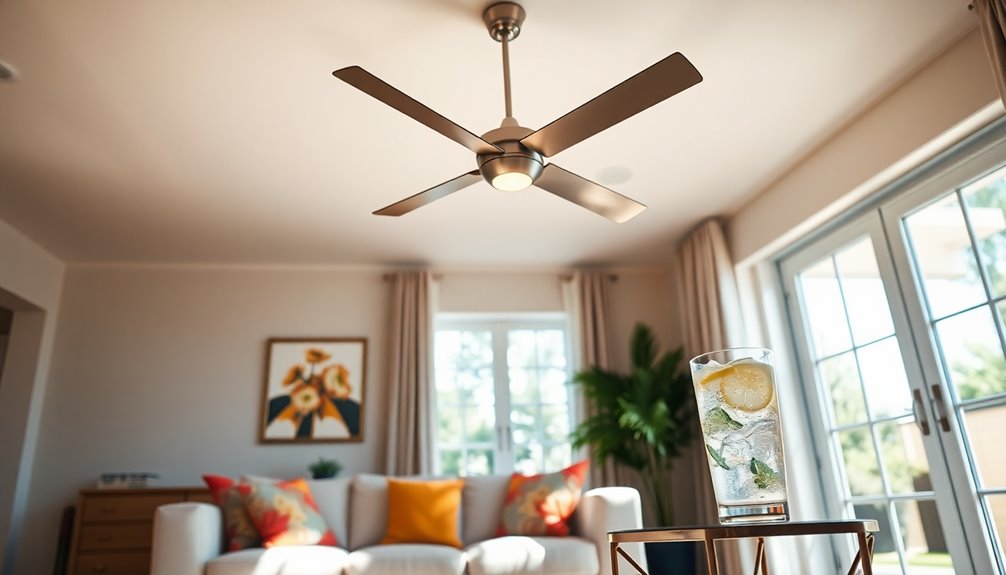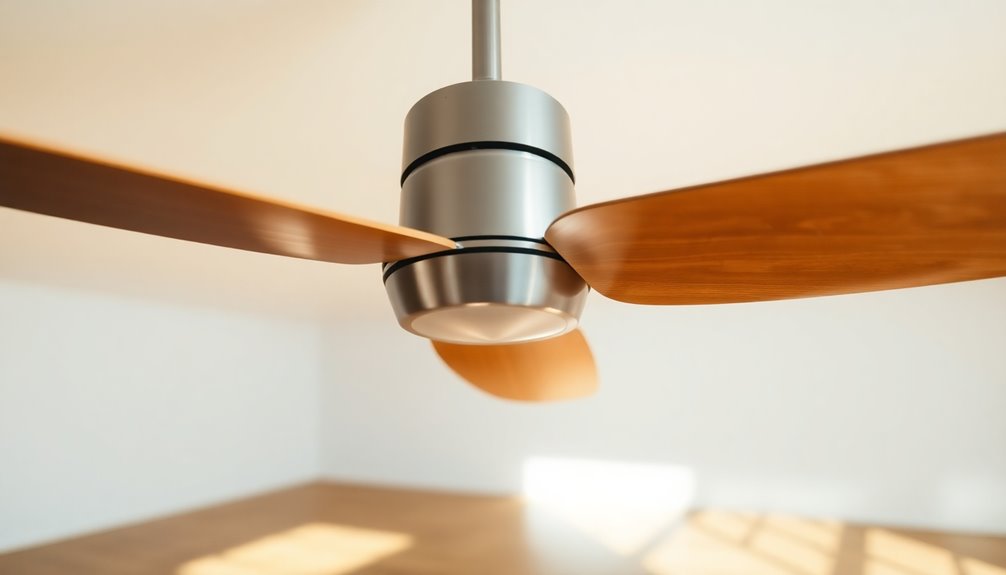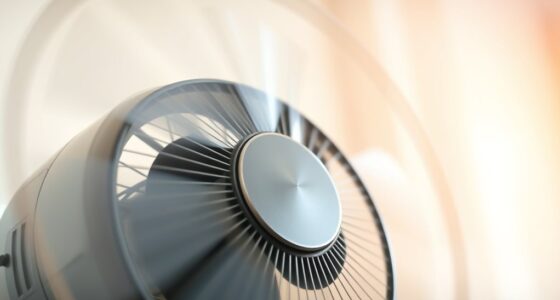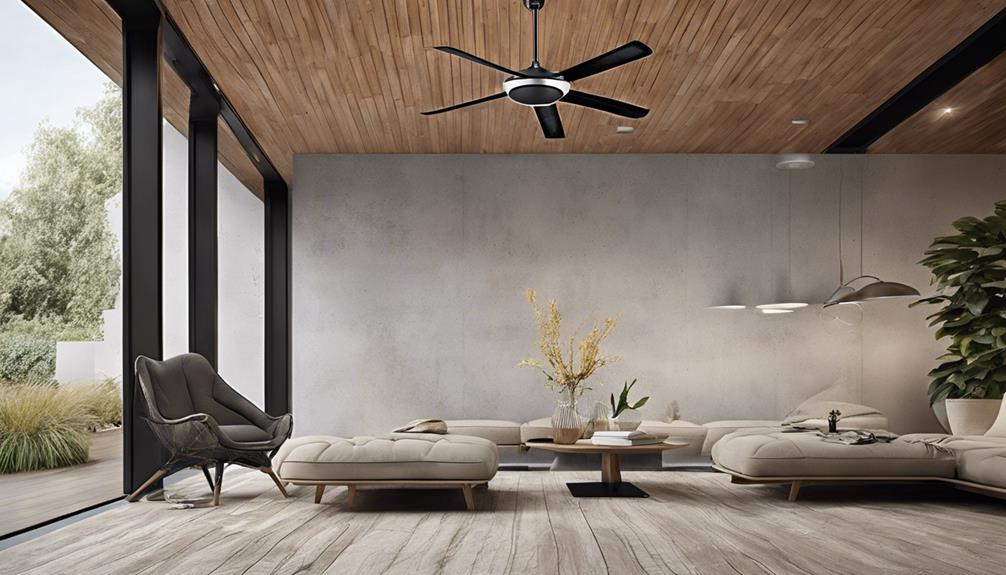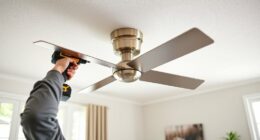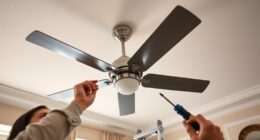Ceiling fans don't actually cool the air like an air conditioner, but they create a wind chill effect that helps you feel cooler. By circulating air, they can make a room feel up to 4°F cooler through moisture evaporation from your skin. Set your fan to rotate counterclockwise in summer for best results. Using a ceiling fan alongside your air conditioning can enhance comfort and potentially save on energy costs, too. Plus, fans help keep air fresh and prevent stagnation. Curious about how to maximize your fan's efficiency? There's more useful info ahead!
Key Takeaways
- Ceiling fans do not lower room temperature but create air movement, making it feel cooler through the wind chill effect.
- By rotating counterclockwise, ceiling fans enhance airflow and can make a room feel up to 4°F cooler.
- They improve air circulation, allowing for higher thermostat settings on AC units, leading to energy savings.
- While fans enhance comfort, they do not remove humidity; combining them with AC improves overall cooling and humidity control.
- Regular maintenance of fans is essential for optimal airflow and efficiency, ensuring better perceived cooling in the room.
Understanding Ceiling Fan Functionality

When it comes to understanding ceiling fan functionality, it's essential to know that these fans don't actually lower the room temperature. Instead, they create air movement that enhances your cooling effect through the wind chill effect on your skin.
When you have a ceiling fan running, it can make a room feel up to 4 degrees cooler, thanks to the increased evaporation of moisture. This process aids your body's natural cooling mechanism.
For ideal comfort and energy efficiency during summer, set your fan to rotate counterclockwise. This maximizes downward airflow, helping circulate air effectively throughout the room.
While the fan blades don't cool the air like an air conditioning unit, they work to maintain air freshness and prevent stagnation, contributing to a more comfortable indoor environment.
Impact on Cooling Costs

Using a ceiling fan can considerably impact your cooling costs, especially during the hot summer months. By running a ceiling fan, you can create a perceived temperature drop of up to 4°F, allowing you to set your thermostat higher without sacrificing comfort.
This simple adjustment can lead to approximately 12% savings on your cooling costs.
When you combine ceiling fans with air conditioning, you can enjoy even more energy savings of up to 14%.
Here's how ceiling fans help:
- They consume about 60 watts, compared to 3000-3500 watts for central AC.
- Ceiling fans improve air circulation, making your space feel cooler.
- You can save on energy costs by turning the thermostat up while using a fan.
- Fans should be turned off in unoccupied rooms to prevent unnecessary energy consumption.
Enhancing Air Conditioning Efficiency

Ceiling fans play an essential role in enhancing air conditioning efficiency by improving air circulation throughout your home. By using a ceiling fan alongside your air conditioning unit, you can raise the thermostat setting by up to 4°F without sacrificing comfort. This not only increases comfort but also leads to significant energy savings—approximately 14%—as the fan helps circulate cool air more evenly.
To maximize the benefits, guarantee your ceiling fans are set to rotate counterclockwise in the summer. This creates a downward draft, enhancing the cooling effect of your air conditioning system. Properly sized and strategically placed ceiling fans can also address hot spots, reducing reliance on your AC unit. Additionally, using ceiling fans in conjunction with air purifiers can further enhance indoor air quality and comfort.
Here's a summary of how ceiling fans enhance air conditioning efficiency:
| Benefit | Description |
|---|---|
| Improved Air Circulation | Helps maintain a consistent indoor temperature |
| Increased Comfort | Allows for higher thermostat settings without discomfort |
| Energy Savings | Reduces overall energy consumption by 14% |
| Efficient Home Cooling | Distributes cool air evenly and addresses hot spots |
| Reduced AC Workload | Less strain on the air conditioning system |
Using ceiling fans effectively can transform your home cooling experience.
Ceiling Fans and Humidity Control

Comfort in a humid environment often feels elusive, but ceiling fans can play a supportive role in managing that sensation. While they don't physically remove humidity like air conditioning does, ceiling fans create air movement that facilitates moisture evaporation from your skin, enhancing your comfort level. This is particularly helpful in reducing perceived dampness, especially after a rainy day.
For ideal humidity management, consider these key points:
- Ceiling fans can enhance the cooling effect of air conditioning.
- They help stir up air, creating a more comfortable indoor environment.
- Combining fans with air conditioning improves overall humidity control.
- Fans don't filter or dehumidify air on their own.
Using ceiling fans in conjunction with air conditioning systems can greatly improve your indoor comfort. While fans alone won't solve humidity issues, they can make a substantial difference in how you perceive the dampness.
As a result, for effective humidity control, embrace the combination of ceiling fans and air conditioning to create a balanced indoor atmosphere that feels invigorating, even on the stickiest days.
Air Quality Considerations

When it comes to indoor air quality, relying solely on ceiling fans can fall short. While ceiling fans effectively create air movement, they don't filter or purify the air like air conditioning systems do. This means they won't directly improve your indoor air quality. Instead, they can stir up dust, pet hair, and other allergens, potentially worsening air quality in your space.
Unlike HVAC systems, which continuously filter and purify air, ceiling fans only circulate air without removing contaminants. If you're using ceiling fans to manage air quality, it's essential to recognize their limitations. They can help disperse odors, but they can't replace the need for proper cleaning and maintenance of your HVAC systems and air filters.
To enhance your indoor air quality, consider combining ceiling fan usage with regular cleaning of surfaces and maintaining your air conditioning system. This way, you'll guarantee that allergens and contaminants are kept at bay, creating a healthier living environment.
Don't underestimate the importance of a thorough approach to air quality for the best results.
Tips for Effective Use

To make the most out of your ceiling fan, it's important to use it effectively alongside your other cooling strategies. Ceiling fans help air circulate, making you feel cooler without having to lower the thermostat drastically.
Set your ceiling fan to rotate counterclockwise during summer to create a downward airflow that enhances the wind chill effect on your skin. This simple adjustment can keep you cool and comfortable.
Here are some tips to maximize your ceiling fan's efficiency:
- Use your ceiling fan with air conditioning: This allows for thermostat adjustments of up to 4°F, helping you save money on energy costs while keeping your space comfortable.
- Turn off fans in unoccupied rooms: Remember, fans cool people, not rooms. Running them unnecessarily increases energy consumption.
- Choose the right fan size: For spaces up to 225 square feet, consider a 36-44 inch fan. Larger rooms may need fans 52 inches or more for effective air movement.
- Regular maintenance: Clean blades and verify proper installation height to maintain ideal airflow and efficiency.
Implement these tips to enjoy a cooler home while reducing your energy costs.
Frequently Asked Questions
Can a Ceiling Fan Make a Room Cooler?
A ceiling fan can make a room feel cooler, but it doesn't actually lower the temperature.
It creates airflow that enhances the wind chill effect, making you feel more comfortable.
When you turn on the fan, you're promoting evaporation of sweat from your skin, which helps your body cool down naturally.
Do Ceiling Fans Help With Hot Rooms?
Yes, ceiling fans can definitely help with hot rooms!
They create airflow that makes you feel cooler, even if the actual temperature doesn't drop. You'll notice a difference in comfort as the moving air enhances the wind chill effect.
Just remember to use fans in occupied spaces and pair them with air conditioning for the best results.
Turning off fans in empty rooms can also save energy while keeping your living space more comfortable.
Do Ceiling Fans Help When AC Is On?
When you run your ceiling fan while the AC is on, it definitely helps!
The fan creates a wind chill effect, making you feel cooler without actually lowering the room temperature. This allows you to set your thermostat a few degrees higher, saving energy and money.
Plus, it circulates the cooled air from the AC, improving comfort and addressing any hot spots in the room.
You'll notice the difference in efficiency and comfort!
How Many Degrees Can a Ceiling Fan Cool a Room?
You might be wondering just how effective a ceiling fan can be.
Surprisingly, it doesn't cool the room in the traditional sense. Instead, it creates a wind chill effect that makes you feel cooler. You can feel a difference of up to 4 degrees when the fan runs counterclockwise.
So, an 80°F room can feel like 76°F, enhancing your comfort without actually changing the air temperature.
It's a clever way to stay cool!
Conclusion
In the dance of summer heat, a ceiling fan isn't just a luxury; it's your trusty partner. While it doesn't lower the temperature, it creates a breeze that makes you feel cooler and helps your AC work smarter, not harder. By understanding how to use it effectively, you can save on cooling costs and improve air quality. So, embrace this whirling wonder and let it elevate your comfort while keeping your wallet happy!
